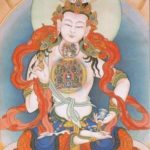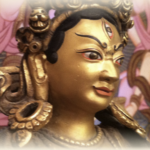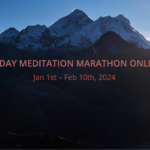A Guide for Beginners
by Pema Khandro
What is Meditation
Buddhist meditation is a practice of wakeful presence. During meditation, everything outside ourselves is left as it is. Attention is focused on the present moment. The purpose of meditation is to wake up from the maze of habitual dissatisfaction. The goal is to be simply present to experience things as they are.
Which Kind of Meditation?
There are many different types of Tibetan Buddhist Meditation practice. These include silent sitting practices like calm abiding (1) or analytical practices like insight meditation (2). Buddhism also offers loving-kindness meditations and compassion meditations such as sending and taking (3). In esoteric Buddhism a primary practice is a visualization and mantra practice of merging one’s own heart and mind with the Buddha (4). Meditative practices also include recitation of prayers of refuge and prayers of the awakened mindset (5). There are many meditations for particular life experiences such as dream yoga, conscious dying (6), healing meditations, longevity meditations, internal yogas, breathing and energy practices (7). There are many somatic practices using physical gestures and movements, fasting practices (8) and many rituals.
Among all these practices Dzogchen meditation is known as the most simple and direct practice for awakening natural presence. The details and stages of Dzogchen meditation are given directly from teachers to their students. However, it is founded on the simple practice of silent sitting meditation with awareness on the breath, also known as “Calm Abiding.”
1. How to Sit
The most important thing is proper physical posture. This is so important that the great sixteenth century Buddhist teacher Dakpo Tashi Namgyal said that some people can even attain the meditative state simply by sitting properly!
The instructions for how to do sitting meditation are known as the
“7 Point Posture of Complete Illumination”
རྣམ་པར་སྣང་མཛད་ཀྱི་ཆོས་ཀྱི་ཆོས་བདུན།
Also known as the “7 Point Posture of Vairochana.”
This sitting meditation posture is named as the seven point posture of “Buddha Vairochana.” His name, Buddha Vairochana literally means “Buddha of Complete Illumination.” This way of sitting forms the basis of most silent sitting Buddhist meditation practices, though there may be some variation according to the different lineages.
-
རྐང་པ་སྐྱིལ་ཀྲུང། Sit in a Cross legged posture.
This is generally one of two postures, the “Bodhisattva posture” sitting with the legs crossed with one leg in front of the other. Or the “Vajra posture,” also known as “Full lotus.” If these positions are not comfortable, then you can also sit in a chair, with the feet flat on the ground. Make sure to sit all the way back in the chair so that your posture is naturally upright. The keys are that the body is stable, upright and comfortable. -
ལག་པ་མཉམ་གཞག། Arrange the hands in the gesture of equanimity.
The two hands are folded together on one’s lap, one on top of the other. This is the same position that the Buddha held his hands into when he meditated on the night of his awakening. -
སྒལ་པ་བསྲང་ཞིང་ལུས་ཀུན་བསྒྲིམ། Straighten your back and engage your entire body.
If you are sitting in a crossed leg position, this naturally allows the spine to stack itself upright. That upright position promotes circulation to the upper body, room to breath naturally and a sense of ease. However if you have tight hips, this doesn’t happen, so a key to sitting up right will be to sit on a cushion so that the hips are higher than the knees (the way they would be if your hips were more flexible). -
མགྲིན་པ་ཅུང་ཟད་གུག་པ། The neck is a little bent.
In other words, tuck your chin inward and back. This is similar to a “double chin” but not quite so dramatically, in order to align the head on top of the spine. -
དཔུང་པ་རྒོད་གཤོག་ལྟར་བརྒྱང་བ། Your shoulders are extended (“like vulture wings”).
In other words, the expanse cross the shoulders is wide, with the chest open. This allows the breath to flow freely, gently and naturally. -
མིག་སྣ་རྩེར་ཕབ་པ། Eyes gaze down towards the tip of the nose.
They gaze is a gentle peaceful gaze (as opposed to staring). The eyes look down towards the tip of the nose. The eye lids are half closed, half open. In some meditation traditions the eyes are closed, but in Buddhism, the eyes stay open due to the goal of being present with direct experience. -
ལྕེ་རྩེ་ཡ་རྐན་ལ་སྦྱར་བ་སྟེ་བདུན་ནོ། The tip of the tongue is at the upper palate.
The teeth or not clenched so there should be a slight space naturally between the teeth. The jaw is relaxed and the tongue is resting at the roof of the mouth.
2. Make A Wish
Before beginning your meditation practice. Make a wish in your heart that all beings everywhere would be free from suffering. Imagine all beings finding peace.
This practice known as the enlightened intent, or awakened mindset. In Sanskrit is is called “Bodhichitta,” an important term to know for Dzogchen meditation. “Bodhichitta” represents the natural state. It is also the mindset of kindness, compassion and the impulse for awakening. Before meditating, always begin by cultivating this enlightened intent.
We do this by saying daily prayers at the start of each session.
3. Where to Put Mind
The main meditation practice to begin with is very simple.
Start by focusing. Listening to sounds around you, you can tune into your environment.
Then turn your attention inward, on the sensations of your body, letting go of any tensions. If your mind is drifting towards external things, simply let those things be as they are for the time being. Bringing your attention to the experience of sitting. Then gradually as you settle in, focus the mind.
Let the mind remain one pointed, focusing on the flow of the outward flowing breath. If your mind wanders away as it habitually does, then simple bring the attention back to the exhalation. You can even take one longer exhalation while you refocus your attention on the breath.
There is no need to silence the mind through force. Instead just let thoughts dissolve naturally on their own as they will when you keep redirecting your attention to the breath.
Start with five minutes at a time, then add five more minutes every few days until you get to your desired length of practice. The important matter is quality, not quantity.
Notes
You may recognize these practices by their Tibetan and Sanskrit names:
- Tib. “Zhine” zhi gnas; Skt. Shamatha
- Skt. Vipassana; Tib. “La tong” Lhag mThong
- Tib. “Tonglen” gTong len
- Tib. “Lama Naljor” bLa ma’i rNal ‘byor; and “Druptap,” sgrub Thabs – Skt. Sadhana
- Skt. Bodhichitta
- Tib. “Phowa,” pho ba
- Tib. “sa-lung,” rtsa rlung
- Tib. “Nyungne” smyung gnas
This article is exceprted from an Introduction to Meditation course with Pema Khandro.
You will find answers to frequently asked questions about practice and study with Pema Khandro here.





